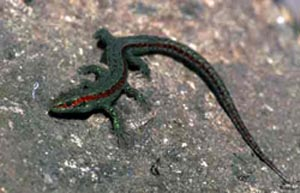Difference between revisions of "Corpse Lizard"
From World of Entorais Wiki
Jump to navigationJump to searchm (photo) |
m (layout) |
||
| Line 1: | Line 1: | ||
[[File:corpse_lizard_male.png|thumb|right|100x|Corpse Lizard Male- digital photo manipulation by "Sebastian Romu"]] | [[File:corpse_lizard_male.png|thumb|right|100x|Corpse Lizard Male- digital photo manipulation by "Sebastian Romu"]] | ||
= | ==About== | ||
;Common Names: Corpse Lizard, Grub Newts, Balaryn Dym ([[Kythus]]) | ;Common Names: Corpse Lizard, Grub Newts, Balaryn Dym ([[Kythus]]) | ||
=Description= | ==Description== | ||
;Classification:Reptile | ;Classification:Reptile | ||
;Size: The average adult of this species is between 10-20 cm long, with 50% of their length being tail. | ;Size: The average adult of this species is between 10-20 cm long, with 50% of their length being tail. | ||
| Line 10: | Line 10: | ||
;Variance: <!--any other variance, include subspeciation--> | ;Variance: <!--any other variance, include subspeciation--> | ||
=Ecology= | ==Ecology== | ||
;Habitat:They are most often found in or near standing water in mountainous or hilly regions. As cold blooded creatures they are most active during warm weather and will hibernate through the winter months. | ;Habitat:They are most often found in or near standing water in mountainous or hilly regions. As cold blooded creatures they are most active during warm weather and will hibernate through the winter months. | ||
;Diet:Scavengers of carrion, but may also eat , small fish, insects, and their larva. | ;Diet:Scavengers of carrion, but may also eat , small fish, insects, and their larva. | ||
=Behaviour= | ==Behaviour== | ||
;Social grouping:As adults they lead solitary lives coming together only to mate. The most common encounter with these tiny creatures is the swarming mass of newly hatched young devouring a carcass. | ;Social grouping:As adults they lead solitary lives coming together only to mate. The most common encounter with these tiny creatures is the swarming mass of newly hatched young devouring a carcass. | ||
;Temperament:These scavengers are wary of other creatures . | ;Temperament:These scavengers are wary of other creatures . | ||
| Line 20: | Line 20: | ||
;Reproduction:Female adults will venture out in search of dead animals. Should they find such a feast, they eat their fill, and then lay a great deal of eggs (100~150) in the carcass and return to the water. When these eggs hatch the young lizards feast upon the carcass, and then make their way towards water. Many do not survive post hatching, as other animals may lie in wait for such a swarming to catch and eat the young lizards. | ;Reproduction:Female adults will venture out in search of dead animals. Should they find such a feast, they eat their fill, and then lay a great deal of eggs (100~150) in the carcass and return to the water. When these eggs hatch the young lizards feast upon the carcass, and then make their way towards water. Many do not survive post hatching, as other animals may lie in wait for such a swarming to catch and eat the young lizards. | ||
=Sub-Species= | ==Sub-Species== | ||
<!--list of sub-species with notable differences--> | <!--list of sub-species with notable differences--> | ||
=Domestication= | ==Domestication== | ||
;General:None | ;General:None | ||
;Resources:None | ;Resources:None | ||
=See Also= | ==See Also== | ||
<!--links to related material--> | <!--links to related material--> | ||
[[Category:Fauna]] | [[Category:Fauna]] | ||
[[Category:Reptile]] | [[Category:Reptile]] | ||
Revision as of 22:16, 3 February 2020
About
- Common Names
- Corpse Lizard, Grub Newts, Balaryn Dym (Kythus)
Description
- Classification
- Reptile
- Size
- The average adult of this species is between 10-20 cm long, with 50% of their length being tail.
- Appearance
- These tiny lizards are dark green to black in colour. Their six stubby limbs end in small webbed feet which combined with their long tails help them swim with remarkable agility.
- Sexual dimorphism
- Males have a red strip along each side.
- Variance
Ecology
- Habitat
- They are most often found in or near standing water in mountainous or hilly regions. As cold blooded creatures they are most active during warm weather and will hibernate through the winter months.
- Diet
- Scavengers of carrion, but may also eat , small fish, insects, and their larva.
Behaviour
- Social grouping
- As adults they lead solitary lives coming together only to mate. The most common encounter with these tiny creatures is the swarming mass of newly hatched young devouring a carcass.
- Temperament
- These scavengers are wary of other creatures .
- Intelligence
- Animal intelligence
- Reproduction
- Female adults will venture out in search of dead animals. Should they find such a feast, they eat their fill, and then lay a great deal of eggs (100~150) in the carcass and return to the water. When these eggs hatch the young lizards feast upon the carcass, and then make their way towards water. Many do not survive post hatching, as other animals may lie in wait for such a swarming to catch and eat the young lizards.
Sub-Species
Domestication
- General
- None
- Resources
- None
